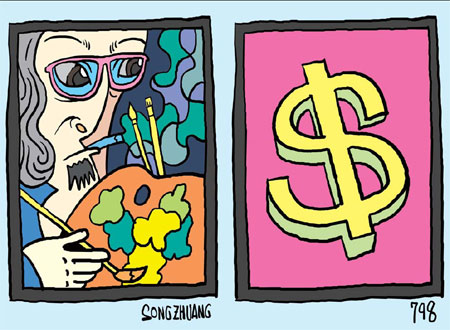

People often gain their first impressions of the city's contemporary art scene from the 798 Art Zone.
However, those who visit Songzhuang will soon find that it is this area and not 798 that is home to the city's largest colony of talented artists from all over the country.
And, I think it is more interesting at the moment.
It is my fifth or sixth visit to Songzhuang. This time, I go to cover the ongoing Sixth Songzhuang Art and Culture Festival.
For the people who haven't been there, a brief introduction to the area is probably needed before I continue.
Located in east Beijing's Tongzhou district, Songzhuang used to be no different from any other suburban areas of the city.
It stood out later when it became home to the country's first group of avant-garde contemporary artists in the 1990s - people such as Fang Lijun and Yue Minjun.
These artists, not famous at that time, had nowhere else to go after the artists' village near Yuanmingyuan was developed in 1994.
Today, Songzhuang houses around 4,000 freelance artists from all over the country.
Fourteen art museums and hundreds of galleries and artists' studios are scattered around the area.
For those who have cars with GPS, I will not bother to instruct you how to get there. But for the art lovers like me who don't have a car, take the 938-9 bus from Guomao Bridge and it will transport you all the way there in about 40 to 50 minutes.
It's worth visiting because you can enjoy fresh air and an artistic atmosphere at the same time.
Today, 798 has lost that feeling. When I first went there in 2003, it was just like today's Songzhuang: everything was incomplete but more interesting.
Now, as one professor involved in the study of creative industries once told me, 798 has become Beijing's fourth must-go place for tourists, especially foreigners, after they have ticked off the Great Wall, the Forbidden City and a Peking roast duck restaurant.
The side effect of its popularity is the chaos brought about by the crowds of tourists and the surging rents.
Especially during the holidays, everywhere you go, you are confronted with tourists and the clicking of cameras.
It has become more popular and more commercial and the art exhibited there gives you a feeling that it has been over-decorated. And artists, especially those just starting out, cannot afford the high rents.
But in Songzhuang, such a transformation hasn't started yet.
Even during the weekends, you will not feel the village is packed. Whenever you feel tired after touring around the galleries and museums, it is easy to find a small restaurant for a cheap bowl of homemade noodles.
Talking with villagers about how they feel about the avant-garde art on their doorstep is also a lot of fun.
The one-month art festival in Songzhuang this year is a "crossover" event.
In addition to the exhibitions that feature both Chinese and foreign painters, the organizers have also invited poets and musicians to give the festival more depth.
I felt the village itself was the strongest proof of the concept, when I saw a cattle cart pass by a very cool and giant installation piece by some bold artist, an example of the coexistence of rural life and art.
Songzhuang is aiming to become the capital's central art district. But I do not want to see Songzhuang copy 798's blueprint.
Art can only thrive in a free environment, even if it is under-developed. For poor but aspiring artists, a well-regulated art zone with a commercial atmosphere will not be attractive.
It is not important whether Songzhuang will be the next 798 or replace 798 in the future.
It needs to be itself, and keep a balance between its natural beauty and artistic ideals.
China Daily

(China Daily 09/27/2010)